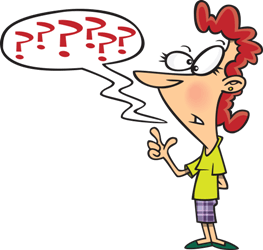Question Marks
Rules and Examples
Review
 Question marks, periods and exclamation points are three types of
punctuation marks used at the end of a sentence.
Question marks, periods and exclamation points are three types of
punctuation marks used at the end of a sentence.Click Here for Step-by-Step Rules, Stories and Exercises to Practice All English Tenses
A sentence is a group of words that are put together to make one complete thought. We use punctuation marks at the end of every sentence.
1) Use a period (.) at the end of a sentence that is a statement.
Examples:
- I like cats.
- Apples are red.
Examples:
- Watch out!
- I won the race!
Examples:
- Where is the bathroom?
- Are you home?
Uses of question marks

1) Use a question mark when you are trying to get information. This type of sentence is called an interrogative sentence.
Many interrogative sentences start with question words such as who, what, when, where, why or how and end with a question mark.
Examples:
- Where is the gas station?
- Who is your teacher?
- Why did you stop here?
- How did you do that?
- What color is the shirt?
- When will you arrive?
Examples:
- Did they go to the party?
- Does he like apples?
- Do you know her name?
- Are you there?
- Is she the teacher?
Examples:
- You promise to call me every day?
- See you there at 8:00 tonight?
A tag is a word or phrase that is added to a sentence.
A tag question is a statement followed by a short question. Tag questions are very common in English and are used to ask if you agree with the statement.
Examples:
- You speak English, don't you?
- The dog is brown, right?
- You paid the bill, didn't you?
- Lisa is not here, is she?
Example:
- Do you want to eat pizza? chicken? hamburgers?
- Do you want to eat pizza, chicken or hamburgers?
A rhetorical question is a type of question to which no answer is required.
Examples:
- Who cares?
- Isn't it a beautiful day?
- Are you kidding me?
Tips for using question marks
1) DO NOT use a question mark after an
indirect question. An indirect question is question found in a declarative sentence.
A declarative sentence is a sentence in the form of a statement. It is not a command or question. It simply states an idea.
Incorrect: I asked her to pay the bill?
Correct: I asked her to pay the bill.
Incorrect: The teacher asked for their homework?
Correct: The teacher asked for their homework.
2) DO NOT put a space before a question mark.
Incorrect: What color is the ball ?
Correct: What color is the ball?
These were the uses of the question mark. Now that you know them, it is time to practice! Read and do exercises.
Get Updates, Special Offers, and English Resources
Download your FREE GIFT (the first two chapters of
English Short Stories Book and Workbook)
as soon as you join!

By submitting your email, you consent to receiving updates and newsletters from us and to the sharing of your personal data with third parties for the purposes of sending you communications. We will not spam you. You can unsubscribe at any time. For more information, please see our privacy policy.





